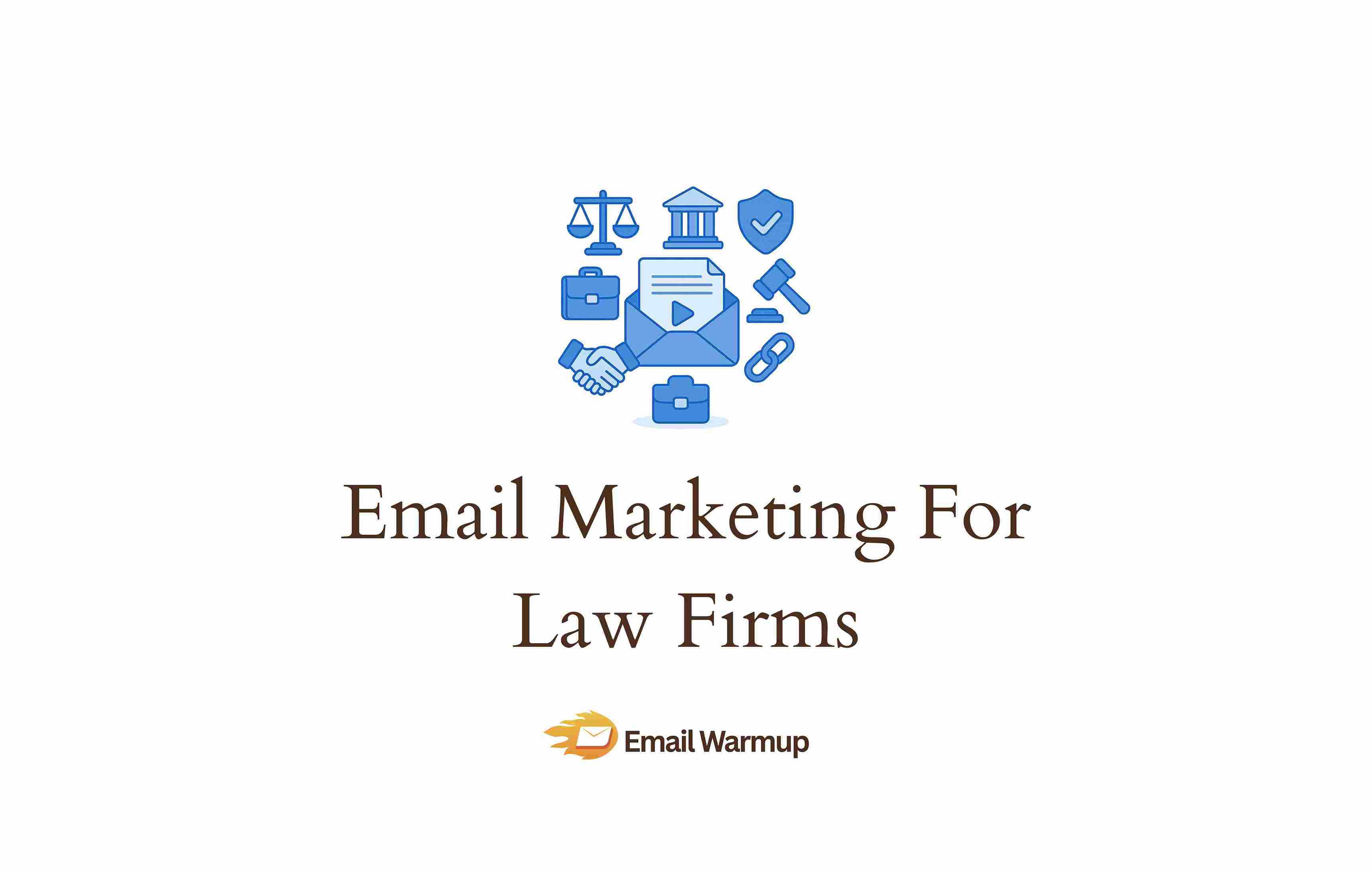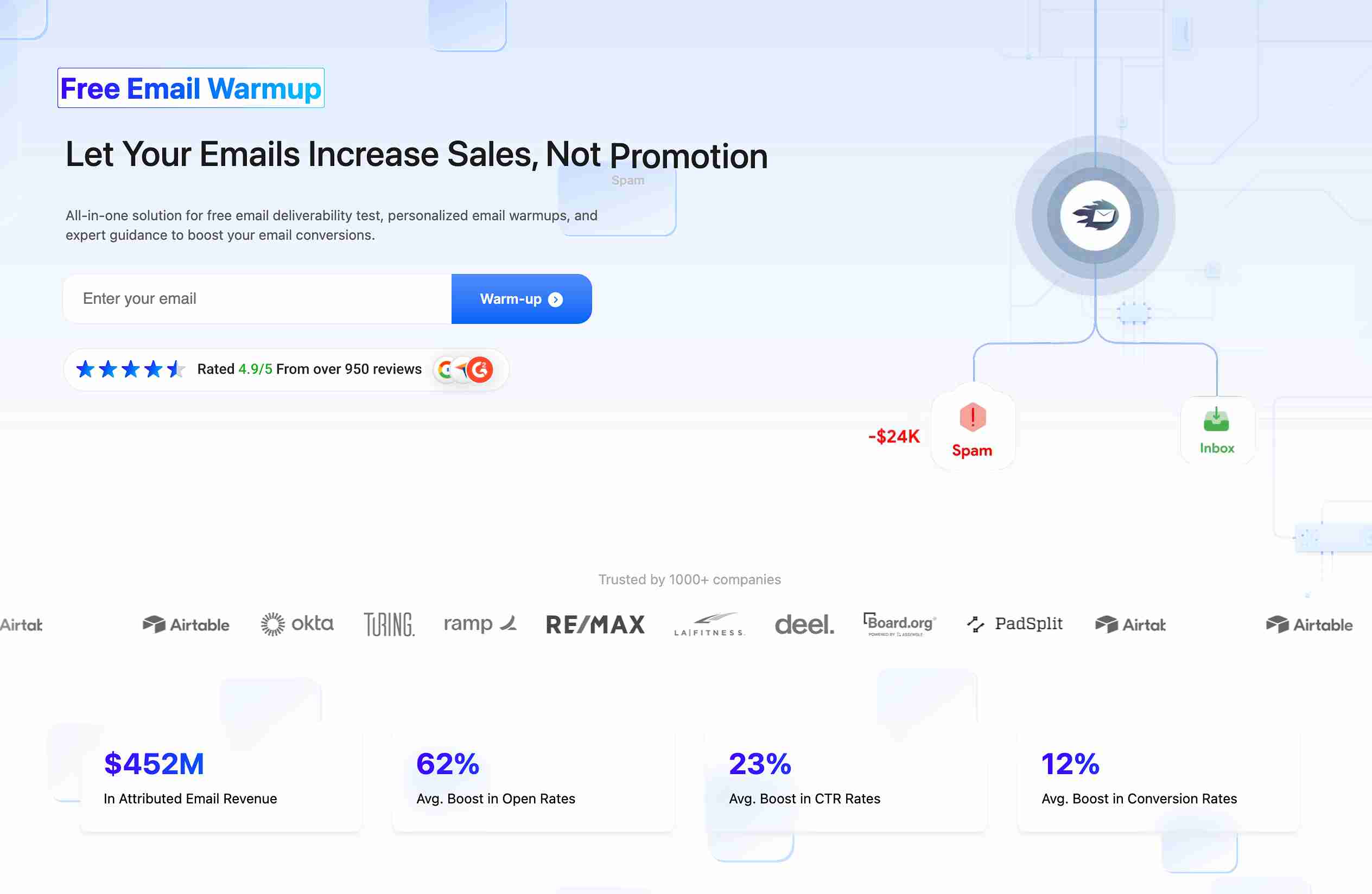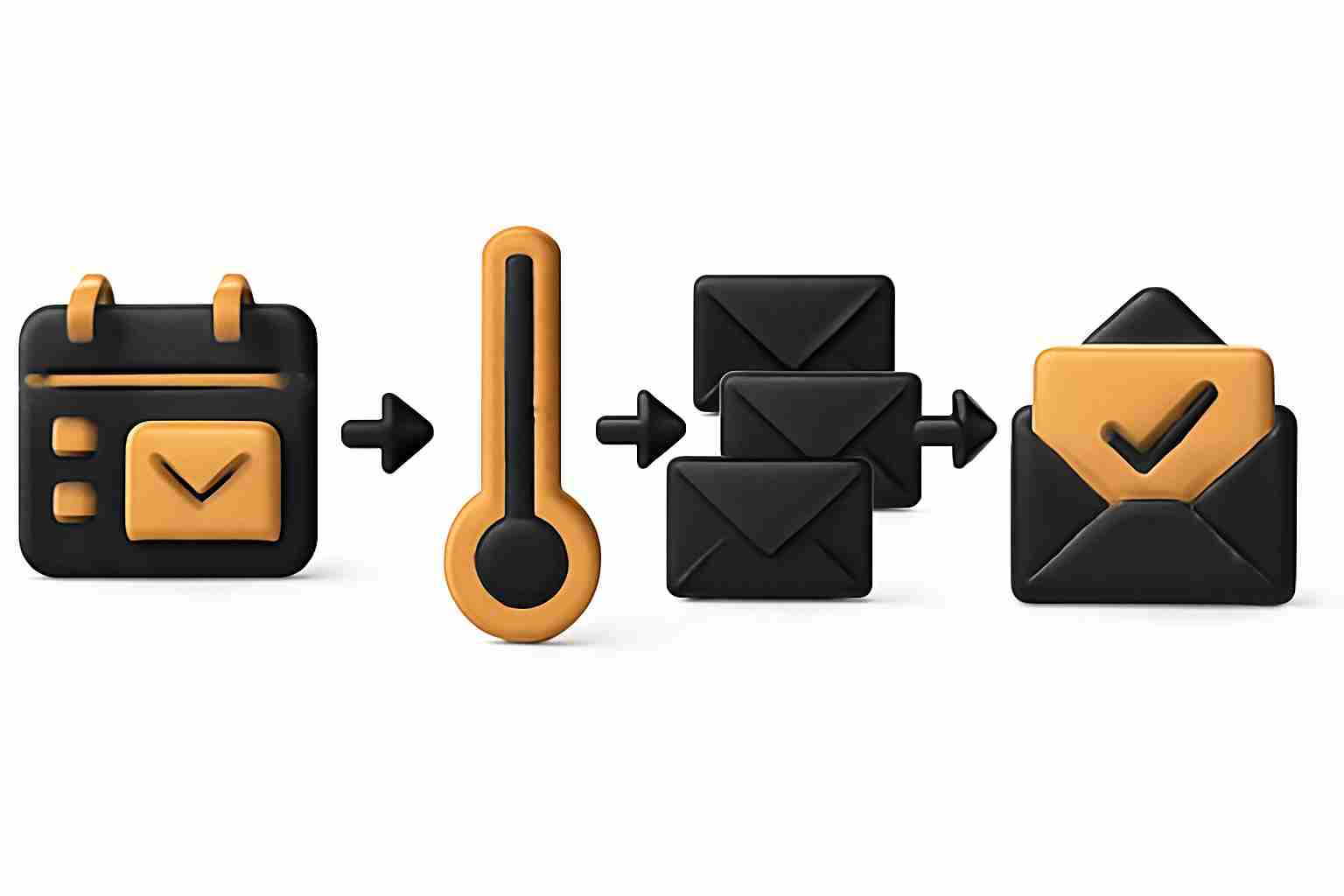
Law firms lose qualified leads daily because their emails never arrive.
According to Clio’s Legal Trends research, only about one-third of email inquiries receive responses, revealing a massive gap in client communication. Meanwhile, HubSpot reports email delivers roughly $36 for every dollar spent across industries.
As an email marketing consultant who has helped law firms achieve 98% inbox rates and generate millions in attributed revenue, I’ve prepared this guide covering:
- Permission-based list building that satisfies bar requirements
- Email formats that generate referrals without sounding desperate
- Technical configuration preventing spam folder placement
- Metrics worth tracking for legal practices
Let’s explore how you can transform your email list into a predictable source of consultations and referrals.
TLDR — email marketing for law firms (quick skim)
Don’t have the time to read the entire piece? No worries. Here’s a framework for email marketing for law firms:
| Strategy component | What to do | Expected outcome |
| List building | Permission-based only (webinar sign-ups, consultation forms, content downloads) | Compliant list growth of 50-100 contacts monthly |
| Email frequency | Educational content twice monthly, legal alerts as needed | 15-25% open rates, 3-5% click rates |
| Technical setup | SPF, DKIM, DMARC configuration plus 14-day warmup for new domains | 95%+ inbox placement |
| Content types | Newsletters, case studies, regulatory updates, event invitations | Consistent referrals and client inquiries |
| Success metrics | Track consultation bookings, referral sources, and client acquisition cost | Clear ROI attribution within 60-90 days |
Get your law firm emails landing in the inbox starting today
You didn’t spend years mastering legal strategy, just so Gmail’s algorithm decides whether your expertise reaches potential clients.

EmailWarmup.com analyzes your actual campaigns and replicates them perfectly during the warmup process. Your emails match your natural sending patterns without triggering spam filters.
- Spam checker extension showing real-time inbox placement
- Personalized email warmup mirroring your real legal communications
- Free unlimited deliverability testing (other platforms charge $25-85 monthly)
- Dedicated deliverability consultant assigned to your account (free)
- Technical setup handled for you (SPF, DKIM, DMARC)
We can set everything up for you right away. Want to know how?
Schedule your consultation call
Why should law firms invest in email marketing?
Most attorneys assume email marketing stopped working years ago — they focus on SEO, paid ads, or hope referrals keep coming.

HubSpot’s industry research shows email returns roughly $36 for every dollar spent. A single corporate client paying $50,000 annually makes your entire email investment worthwhile (most firms spend $500-2,000 monthly).
| Marketing channel | Monthly cost | Predictability | Asset ownership |
| Email marketing | $500-2,000 | High (list compounds) | You own the list |
| Google Ads | $3,000-10,000 | Low (stops when you stop paying) | You own nothing |
Email marketing compounds as your list grows and your reputation strengthens. Meanwhile, paid ads stop working the moment you stop paying.
How do you build an email list for your law firm without violating ethics rules?
Bar associations have strict rules about solicitation. Understanding the difference between solicitation (targeting specific people with known legal problems) and marketing (sharing general information with people who requested it) makes compliance straightforward.
Permission-based collection
Every person on your list must explicitly agree to receive your communications — no buying lists or scraping LinkedIn. Seth Godin explained it perfectly in Permission Marketing:
“Permission marketing turns strangers into friends and friends into loyal customers.”
Bar association compliance basics
According to ABA Model Rule 7.3 and CAN-SPAM requirements, your emails must include your firm name, location, a clear unsubscribe method, and no misleading claims.

You cannot email people who recently experienced specific legal problems unless they contacted you first. So if someone attended your seminar, it is entirely acceptable to email them educational content.
Collection methods
- Pop-ups offering downloadable guides
- Consultation forms with newsletter subscription checkbox
- Quarterly webinars requiring registration (30-50 qualified addresses per event)
- Speaking engagements with sign-up sheets or QR codes
- Published articles with calls to action
Running regular email deliverability tests ensures your list-building efforts pay off, as growing a list is pointless if messages land in spam.
What types of emails work best for law firms?
Attorneys often send only promotional emails. Your readers don’t care about internal updates unless they directly benefit.
| Email type | Frequency | Purpose | Length |
| Educational newsletters | Twice monthly | Position as an expert, stay top of mind | 500-800 words |
| Legal alerts | As needed | Timely regulatory/court updates | 200-300 words |
| Case studies | Monthly | Demonstrate expertise through results | 400-600 words |
| Event invitations | Quarterly | Build deeper relationships | 150-200 words |
| Referral nurturing | Monthly | Stay visible to referral sources | 300-500 words |
Educational newsletters
Send these twice monthly. Each newsletter covers one specific legal topic that your clients actually worry about. Write in plain English. Explain why the topic matters, what changed, and what action readers should take.
End with “Questions about how this affects your business? Reply to this email.” Your readers should finish thinking “That was helpful” rather than “They’re trying to sell me something.”
Case studies
Anonymize everything. You have to show your thought process: “We initially considered strategy A, but discovered issue B, so we pivoted to strategy C.”

Legal alerts
According to the Legal Marketing Association’s CMO Survey, timely content delivery ranks among the top tactics for client retention. When a court decision or regulation affects your clients, email them immediately with: what happened, what it means, and what they should do now.
Event invitations
Webinars, seminars, and roundtables make a huge difference. Someone might ignore your newsletters but show up to a free estate planning seminar. Once they’re in the room, you can demonstrate expertise in ways email never quite captures.
Referral nurturing
Create a separate sequence for referral sources (other attorneys, financial advisors, accountants). Share case types you’re seeking, updates about successful cases from referrals, and useful content that their clients would appreciate.
How do you write your law firm emails to build trust without sounding desperate?
Legal email marketing fails when attorneys sound too stiff (boring) or too salesy (desperate). Your readers are intelligent people facing serious situations.
Skip the formal legalese. You’re having a conversation with someone who needs guidance. Ann Handley put it perfectly in Everybody Writes:
“Writing well is part habit, part knowledge of some fundamental rules, and part giving a damn.”
Subject lines that respect intelligence
“June 2024 Newsletter” gets ignored. “New custody ruling affects your parenting plan” gets opened. The subject line should tell readers exactly why they should care right now.
Personalization beyond first names
Reference their industry. Mention the webinar they attended. “As a business owner,” works better than generic greetings.
The 90/10 rule
Ninety percent of your email should deliver genuine value. Ten percent can mention your services. Simply ending with “If you’re dealing with this situation and need guidance, reply to this email” feels honest.
What technical setup ensures your law firm’s emails reach the inbox?
You could write the perfect email, and it won’t matter if Gmail dumps it straight into spam.
Email authentication protocols
| Protocol | What it does | Why it matters |
| SPF | Lists the servers that can send emails on behalf of your domain | Prevents domain impersonation |
| DKIM | Adds a digital signature proving the email hasn’t been tampered with | Verifies message integrity |
| DMARC | Tells email providers what to do if authentication fails | Sets the enforcement policy |
Setting these up requires accessing your domain’s DNS records through your hosting provider. Most email platforms provide step-by-step instructions. Plan for 30-60 minutes of technical work.
Domain reputation and warmup
Email providers track how recipients interact with your messages. High open rates and replies signal people want your emails. Spam complaints and immediate deletions signal the opposite.

New domains start with zero reputation. If you’re sending from a brand-new email address, warm it up gradually (start with 10-20 emails daily, increase slowly over 14-21 days).
EmailWarmup.com automates the entire warmup process, using AI to replicate your natural sending patterns. Using the email spam checker browser extension lets you see your deliverability rate in your Gmail or Outlook compose window.
List hygiene
You have to ensure that your list is up to the mark, because bad addresses can hurt your deliverability like hell. Here’s what you should keep in mind:
- Remove addresses that consistently bounce
- When someone hasn’t opened an email in six months, consider removing them
- Stop sending to completely disengaged contacts
Remember that quality matters more than quantity, so your list should be in tip-top condition. You can use an email validation API to help you filter bad addresses.
How do you measure your law firm’s email marketing success?

Open rates and click rates matter, but they’re not the full story. Someone might read every newsletter for six months before scheduling a consultation.
| Metric | Why it matters | How to track it |
| Consultation bookings | Direct revenue indicator | Ask “How did you find us?” during intake |
| Referral source attribution | Measures relationship strength | Track which contacts send client referrals |
| Client acquisition cost | Shows true ROI | Total email expenses ÷ new clients from email |
| Engagement signals | Predicts future business | Monitor replies, forwards, and event attendance |
When someone schedules a call, ask how they found you. “I’ve been reading your newsletter” counts as a win, even if they didn’t click a link in your most recent campaign.
Calculate client acquisition cost by dividing total email expenses by the new clients from email. A family law firm spending $1,500 monthly and acquiring two clients worth $10,000 each sees a 13x return.
- Are people replying with questions?
- Forwarding your content?
- Attending your events?
These signals predict future business even without immediate conversions.
Email marketing for law firms operates on longer sales cycles than most industries. Expect some results within 60-90 days. Zero consultation requests, zero referrals, and zero engagement after three months means something’s wrong (probably your content isn’t resonating or your technical setup is broken).
When AI writes your newsletter better than you do
Five years from now, the attorneys generating serious business from email won’t be writing every word themselves. They’ll be the ones who guide AI to capture their unique perspective.

The paradox is that AI drafts your newsletter in three minutes, but if every law firm uses the same AI to write generic content, everyone sounds identical. The competitive advantage shifts from “who can write well” to “who has genuinely unique insights worth sharing.”
Develop strong opinions about legal trends. Take controversial positions on recent rulings. Share case strategies that worked (or failed). Let AI handle the first draft, then inject the personality and expertise that only you possess.
The law firms winning at email marketing in 2030 will crack this balance: using technology to move faster while staying distinctly human.
Frequently asked questions about email marketing for law firms
Here are some commonly asked questions about email marketing for law firms:
Former clients who didn’t explicitly opt out can receive general marketing emails. However, you cannot solicit them for unrelated legal matters. Always check your state bar’s specific guidance.
Tuesday through Thursday, between 10 AM and 2 PM, generally see the highest open rates. Business attorneys might see better results during business hours, while family law firms might see better evening engagement. Test for three months and track results.
Use automation for welcome sequences, educational series, and regular newsletters. Send manually for legal alerts and personalized follow-ups. Automation saves hundreds of hours yearly while maintaining consistency.
Twice monthly for educational newsletters plus occasional legal alerts works well. Monitor unsubscribe rates (anything above 0.5% per email suggests you’re sending too frequently).
Segment your list if you serve distinctly different audiences. A firm handling both estate planning and criminal defense should maintain separate lists. If your practice areas overlap naturally, one well-segmented list works fine.
Expect 60-90 days minimum. Month one builds your list. Month two grows engagement and trust. Month three typically sees the first consultation bookings. High-value clients often take 6-12 months of nurturing before converting.
References
- American Bar Association. (2024). Model Rules of Professional Conduct: Rule 7.3 Solicitation of Clients.
- Campaign Monitor. (2024). The Email Marketing Playbook for Lawyers.
- Clio. (2024). Legal Trends Report: Client Intake and Engagement Findings.
- Godin, S. (1999). Permission Marketing: Turning Strangers into Friends and Friends into Loyal Customers. Simon & Schuster.
- Handley, A. (2014). Everybody Writes: Your Go-To Guide to Creating Ridiculously Good Content. Wiley.
- HubSpot. (2024). Email Marketing Statistics and Benchmarks.
- Legal Marketing Association. (2025). CMO Survey Report: Marketing Tactics and Client Retention.
- Mailchimp. (2024). Email Marketing Benchmarks by Industry.
- Potter Anderson & Corroon LLP. (2003). How The CAN-SPAM Act of 2003 Affects Electronic Communication By Lawyers.



